ORONO, Maine — Intermedia studies students at the University of Maine have a unique opportunity to use nanocellulose to create art while also conducting research.
Nanocellulose is a material composed of more than 95% water. It's a malleable substance that looks and feels similar to yogurt or paste.
Some of the graduate students are using the substance to create their own variations of art with it.
Alex Rose, an MFA graduate student in her second year at UMaine, is creating art with nanocellulose to see how she can create sensory boards and other activities for students with special needs.
"If I can play with the colors of the natural dyes that are then integrated into the nanocellulose, to make a sensory table of sorts, basically be able to integrate the colors, play with them together just welcome people... yes, of special needs but also those who aren't just to play with the material introduce the material to new people," Rose explained.
The graduate student said one of the things that she likes most about using the material is that it's environmentally friendly and non-toxic.
"As an artist, you can go into a project thinking... or not even as an artist, as any person working on a project, you can go into it thinking this is what I want the outcome to be, and we've had to accept failure. My projects both came out of failing and then finding the beauty within each of those intended projects that had failed and cultivating something new," Rose said.
The nanocellulose is produced right on campus at UMaine's Process Development Center. According to a news release, it's one of the only facilities in the country to produce it by the pound.
Augusta Sparks Farnum, an MFA graduate student at UMaine, said she hopes their art also helps scientists to learn more about what this substance can be used for.
"It's about... reframing that work, right? It is investigation, it is understanding, it is exploring, it is poking, and who's to say what kind of discovery is going to come from that?" Farnum observed.
Farnum said she also hopes their art will start to shift the perspective of only viewing art as what she called "window dressing."
"We want to maintain a seat at the table. We have a different way of talking and a different way of showing you things that we're seeing... it's relatable content, and perhaps it's a reframing of sorts so we may bring something forward that somebody else hadn't thought of yet," Farnum asserted.
Their work is currently on display in the university's Innovative Media Research and Commercialization Center in Orono. A gallery talk is being held on campus on Sept. 13 at 7 p.m. and will be open to the public.
To learn more about intermedia studies at UMaine, click here.
Nanocellulose isn't just being used for art on campus. Researchers at UMaine are also looking into how it can help wild blueberry plants produce more blueberries when used with liquid fertilizer.

